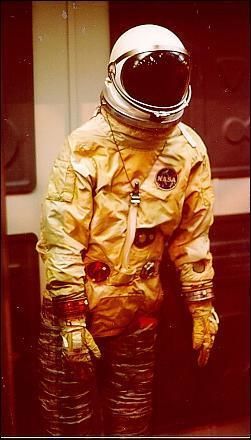
Home - Search - Browse - Alphabetic Index: 0- 1- 2- 3- 4- 5- 6- 7- 8- 9
A- B- C- D- E- F- G- H- I- J- K- L- M- N- O- P- Q- R- S- T- U- V- W- X- Y- Z
G4C AMU
 G4C Suit / AMU Mod Credit: USAF |
AKA: Project Gemini AMU Space Suit, 1966. Status: operational 1966.
The suit was basically a David Clark Gemini G4C suit with leg covers of aluminized material added to prevent heat damage from the AMU thrusters. Astronaut Eugene Cernan wore the suit during the Gemini IX-A mission in June 1966 in an unsuccessful attempt to test the AMU during extravehicular activity.
Family: Space Suits. Country: USA. Agency: USAF, David Clark. Bibliography: 344, 40.
1966 February 23 - .
- The astronaut maneuvering unit (AMU) scheduled to be tested on the Gemini IX mission was delivered to Cape Kennedy. - .
Nation: USA.
Flight: Gemini 9.
Spacecraft Bus: Gemini space suits.
Spacecraft: G4C AMU,
Gemini.
The astronaut maneuvering unit (AMU) scheduled to be tested on the Gemini IX mission was delivered to Cape Kennedy. The receiving inspection revealed nitrogen leaks in the propulsion system and oxygen leaks in the oxygen supply system. Reworking these systems to eliminate the leakage was completed on March 11. Following systems tests, the AMU was installed in spacecraft No. 9 (March 14-18).
1966 March 17 - .
- The extravehicular life support system (ELSS) for Gemini spacecraft No. 9 was delivered to Cape Kennedy. - .
Nation: USA.
Flight: Gemini 9.
Spacecraft Bus: Gemini space suits.
Spacecraft: G4C AMU,
Gemini.
The extravehicular life support system (ELSS) for Gemini spacecraft No. 9 was delivered to Cape Kennedy. Compatibility tests involving the ELSS, the astronaut maneuvering unit, and the spacecraft were completed March 24. The ELSS was returned to the contractor on April 6 for modification.
1966 April 18 - .
- Gemini 9 AMU compatability tests. - .
Nation: USA.
Flight: Gemini 9.
Spacecraft Bus: Gemini space suits.
Spacecraft: G4C AMU,
Gemini.
The extravehicular life support system (ELSS) for Gemini spacecraft No. 9 was returned to Cape Kennedy and underwent an electrical compatibility test with the astronaut maneuvering unit (AMU). An ELSS/AMU Joint Combined System Test was run the following day and rerun April 21. The ELSS was then delivered to Manned Spacecraft Center for tests (April 22) while the AMU was prepared for installation in the adapter. The ELSS was returned to the Cape April 26. AMU Final Systems Test and installation for flight were accomplished May 7. The ELSS was serviced and installed for flight May 16.
1966 June - .
- Gemini 9A (cancelled) - .
Crew: Bassett,
See.
Backup Crew: Cernan,
Stafford.
Nation: USA.
Flight: Gemini 9A.
Spacecraft: G4C AMU,
Gemini.
Elliot See and Charlie Bassett were the prime crew for Gemini 9. On February 28, 1966, they were flying in a NASA T-38 trainer to visit the McDonnell plant in St Louis, where their spacecraft was in assembly. See misjudged his landing approach, and in pulling up from the runway, hit Building 101 where the spacecraft was being assembled. Both astronauts were killed, and 14 persons on the ground were injured. As a result, the Gemini 9 backup crew became the prime crew, and all subsequent crew assignments were reshuffled. This ended up determining who would be the first man on the moon.
1966 September 23 - .
- NASA Headquarters deleted the AMU experiment from the Gemini XII mission. - .
Nation: USA.
Flight: Gemini 12.
Spacecraft Bus: Gemini space suits.
Spacecraft: G4C AMU,
Gemini.
The astronaut maneuvering unit (AMU), which had been installed in Gemini spacecraft No. 12 on September 17, was removed as the spacecraft was undergoing final preparations for movement to complex 19. NASA Headquarters deleted the AMU experiment from the extravehicular activities (EVA) planned for the Gemini XII mission. Additional Details: here....
Back to top of page
Home - Search - Browse - Alphabetic Index: 0- 1- 2- 3- 4- 5- 6- 7- 8- 9
A- B- C- D- E- F- G- H- I- J- K- L- M- N- O- P- Q- R- S- T- U- V- W- X- Y- Z
© 1997-2019 Mark Wade - Contact
© / Conditions for Use